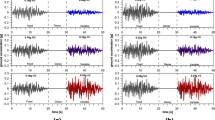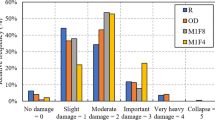Abstract
The present paper deals with the analytical investigation of representative planar masonry-infilled reinforced concrete (MIRC) frames for seismic fragility, performance and demand. The study includes the effect of various patterns of layout for infills panels along the height of reinforced concrete frames. The analytical investigation has been done using non-linear dynamic time-history analysis under collection of forty SAC near-field ground motions using rational hysteretic models for structural components; the results are presented in terms of parameters such as peak inter-storey drift, residual drift and damage index. The outcomes of study are used to develop seismic fragility curves in probabilistic terms for the generic medium-rise MIRC frames. The developed fragility curves can be useful tools in predicting the life and economic losses in the future seismic event. In the current study, efforts are also made to develop curves demonstrating seismic performance and seismic demand for representative MIRC frames.
Similar content being viewed by others
Abbreviations
- ADRS:
-
cceleration-Displacement Response Spectrum
- CP:
-
Collapse Prevention
- CSM:
-
Capacity Spectrum Method
- G:
-
Geometry
- HRC:
-
Homogenized Reinforced Concrete
- IO:
-
Immediate Occupancy
- LRC:
-
Lightly Reinforced Concrete
- LS:
-
Life Safety
- MCE:
-
Maximum Credible Earthquake
- MIRC:
-
Masonry Infilled Reinforced Concrete
- NF:
-
Near Field
- pga:
-
Peak Ground Acceleration
- RC:
-
Reinforced Concrete
- Sa:
-
Spectral Acceleration
- SAC:
-
A joint venture formed by Structural Engineers Association of California (SEAOC), Applied Technology Council (ATC) and Consortium of Universities for Research in Earthquake Engineering (CUREE)
- Sd:
-
Spectral Displacement
References
Asteris P, Cotsovos D, Chrysostomou, C, Mohebkhah A, Al-Chaar G (2013) Mathematical micromodeling of infilled frames: State of the art. Engineering Structures 56:1905–1921
Bilham R, Gaur VK, Molnar P (2001) Himalayan seismic hazard. Science 293(5534):1442–44
Dolsek M, Fajfar P (2008) The effect of masonry infills on seismic response of a four storey reinforced concrete frame — A probabilistic assessment. Engineering Structures 30(11):3186–3192
Furtado A, Rodrigues H, Arêde A (2015) Modeling of masonry infill walls participation in the seismic behaviour of RC buildings using OpenSees. International Journal of Advanced Structural Engineering 7(2):117–127
Ghowsi AF, Sahoo DR (2015) Fragility assessment of buckling-restrained braced frames under near-field earthquakes. Steel and Composite Structures 19(1):173–190, DOI: https://doi.org/10.12989/scs.2015.19.1.173
Hashmi AK, Madan A (2017) Seismic performance of masonry iniflled reinforced concrete structures. Indian Concrete Journal 91(5):24–33
ICC IBC (2000) International building code. International Code Council, Washington DC, USA
IS 1893 (2002) Indian standard criteria for earthquake resistant design of structures: Part 1. General provisions and buildings. Bureau of Indian Standards, New Delhi, India
Koutromanos I, Stravidris A, Shing P, Quenneville J (2011) Numerical modelling of masonry-infilled RC frames subjected to seismic loads Computers and Structures 89:1026–1037
Lang K, Bachman H (2003) On the seismic vulnerability of existing unreinforced masonry building. Journal of Earthquake Engineering 7(3):407–426, DOI: https://doi.org/10.1080/13632460309350456
Lang K, Bachmann H (2004) On the seismic vulnerability of existing buildings: A case study of the city of basel. Earthquake Spectra 20(1):43–66
Madan A, Hashmi AK (2008) Analytical prediction of seismic performance of masonry infilled reinforced concrete frames subjected to near-field earthquakes. Journal of Structural Engineering 134(9):1569–1581, DOI: https://doi.org/10.1061/(ASCE)0733-9445(2008)134:9(1569)
Madan A, Hashmi AK (2014) Performance based design of masonry infilled reinforced concrete frames for near-field earthquakes using energy methods. International Journal of Civil, Architectural, Structural and Construction Engineering 8(6):699–705
Madan A, Reinhorn AM, Mander JB, Valles R (1997) Modelling of masonry infill panels for structural analysis. Journal of Structural Engineering 123:1295–1302, DOI: https://doi.org/10.1061/(ASCE)0733-9445(1997)123:10(1295)
Mostafaei H, Kabeyasawa T (2004) Effect of infill masonry walls on the seismic response of reinforced concrete buildings. Bulletin of the Earthquake Research Institute 79:133–156
Oliveira D, Lourenço P (2004) Implementation and validation of a constitutive model for the cyclic behavior of interface elements. Computers and Structures 82(17–19):1451–1461
Park YJ, Reinhorn AM, Kunnath SK (1987) IDARC: Inelastic damage analysis of reinforced concrete frame-shear wall structures. Technical Report NCEER-87-0008, National Centre for Earthquake Engineering Research, SUNY Buffalo, New York, NY, USA
Ricci P, de Risi MT, Verderame GM, Manfredi G (2013) Influence of infill distribution and design typology on seismic performance of low- and mid-rise RC buildings. Bulletin of Earthquake Engineering 11(5):1585–1616
Somerville PG, Smith M, Punyamurthula S, Sun J (1997) Development of ground motion time histories for phase 2 of the FEMA/SAC Steel Project. Report No. SAC/BD-97/04, SAC Joint Venture, Sacramento, CA, USA
Stravidris A, Shing P (2010) Finite-element modeling of nonlinear behavior of masonry infilled RC frames. Journal of Structural Engineering 136(3):285–296
Valles RE, Reinhorn AM, Kunnath SK, Li C, Madan A (1996) IDARC version 4.0 — A program for the inelastic damage analysis of buildings. Technical Report NCEER-96-0010, SUNY Buffalo, New York, NY, USA
Wen YK, Ellingwood BRm, Bracci J (2004) Vulnerability function framework for consequence-based engineering. Report DS-04, University of Illinois at Urbana-Champaign, Mid-America Earthquake Centre Project, Urbana, IL, USA
Acknowledgements
Not Applicable
Author information
Authors and Affiliations
Corresponding author
Rights and permissions
About this article
Cite this article
Hashmi, A.K., Madan, A. Fragility Analysis of Infilled Reinforced Concrete Frames Subjected to Near-Field Ground Motions. KSCE J Civ Eng 24, 122–130 (2020). https://doi.org/10.1007/s12205-020-1443-x
Received:
Accepted:
Published:
Issue Date:
DOI: https://doi.org/10.1007/s12205-020-1443-x




